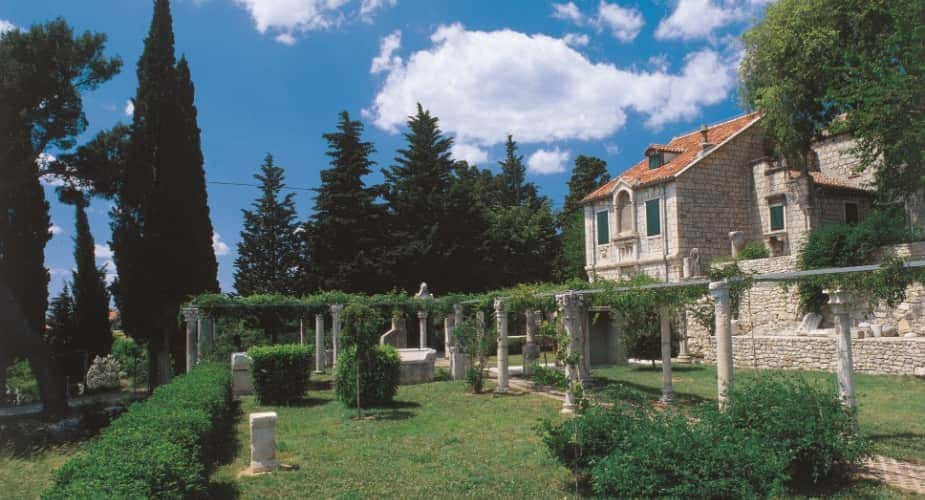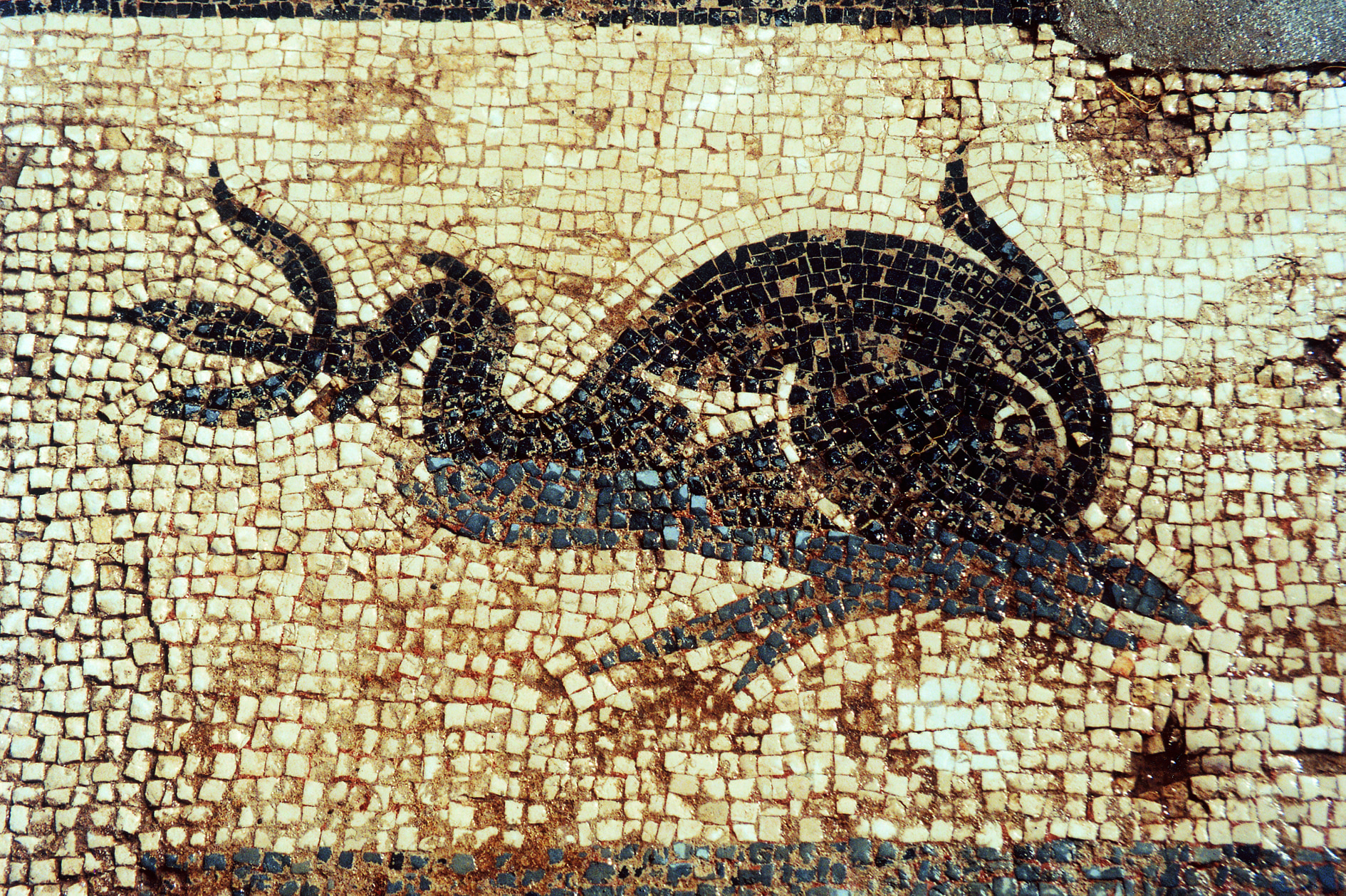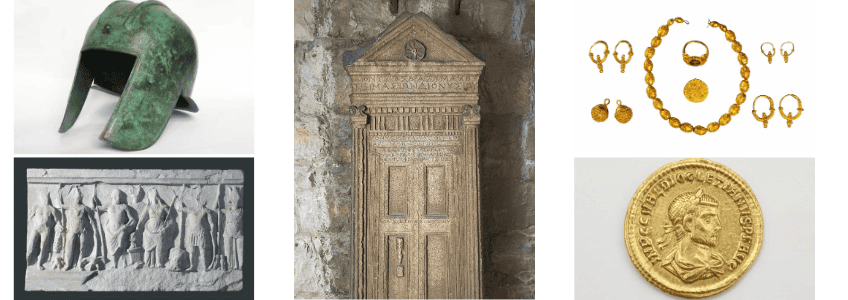History of the Museum
The Archaeological Museum in Split was founded on August 22, 1820, following the visit of Emperor Francis I and his wife Carolina Augusta in 1818. Impressed by the remains of Diocletian’s Palace, particularly the Peristyle and mausoleum, the emperor’s entourage—including young antiquarian Anton Steinbüchel—documented the monuments and sparked the creation of a dedicated museum to preserve Dalmatia’s rich heritage.
Initially, the museum had no permanent building, and its collections were stored in rented spaces. In 1836, a structure was built adjacent to the eastern wall of Diocletian’s Palace, later expanded with additional storage spaces as the collections grew. Persistent efforts by don Frane Bulić, director from 1884, culminated in the construction of the museum’s current building, designed by Austrian architects August Kirstein and Friedrich Ohmann, completed between 1912 and 1914. The museum officially opened to the public in 1922.
Over the years, the museum’s permanent exhibitions have undergone multiple redesigns to adapt to modern standards, with major updates in 1951, 1970, and most recently in 2000. Today, the museum combines historic presentation with practical display solutions, offering visitors an accessible and comprehensive experience of Dalmatia’s past.
The museum’s research activities have been equally significant. Excavations in Salona, Issa (Vis), Narona, and other key sites have yielded invaluable insights into prehistoric, classical, and medieval periods. Bulić’s leadership ensured systematic documentation, establishing the museum as a central hub for archaeological scholarship in Croatia.
The collections include:
- Prehistoric artifacts
- Greek-Hellenistic and Roman-Provincial objects
- Late Antique and Medieval items
- Numismatic and epigraphic collections
- Underwater archaeology finds
- Art, craftwork, and modern monuments
Through acquisitions, excavations, and generous donations, the museum now holds tens of thousands of objects, making it one of Croatia’s most important archaeological institutions. Its library, founded in 1845, houses around 60,000 volumes, including rare books, incunabula, maps, and archival materials critical to Dalmatian history.
Beyond research, the museum has actively promoted cultural engagement through exhibitions, publications, conferences, and events, hosting renowned scholars, artists, and dignitaries, from emperors to contemporary figures. Its innovative programs have made it a dynamic center for education and cultural heritage in Split and beyond.
Today, the Arheological Museum in Split stands as a testament to two centuries of dedication to preserving Dalmatia’s past, offering visitors a rich journey through time, from prehistory to modernity.
Reference Collection and the Salona Site
The Reference Collection houses archaeological artifacts and monuments from the site of Salona, an ancient Roman city located in present-day Solin. The collection includes around 12,000 items discovered during systematic excavations and rescue operations since 1970, and they are stored at the main building of the Archaeological Museum in Split as well as in the Tusculum branch on Manastirine.
Tusculum, built in 1898 at the initiative of don Frane Bulić, served as a research center and visitor accommodation. It features a garden with stone architectural elements, a memorial room dedicated to Bulić, and exhibited archaeological finds, including urns, amphorae, and replicas of altar screens. Of particular importance was Bulić’s library, where visitors could consult books of exceptional cultural and historical value.
Today, Tusculum offers a multimedia experience: visitors can explore permanent exhibitions, participate in educational workshops, presentations, and lectures, while the depot houses valuable artifacts, including stone monuments from Salona. The collection provides a unique insight into the life and culture of the ancient city and into the work of Split’s most renowned archaeologist, don Frane Bulić.
Reference Collection and Issa Site
Historical Overview
Issa (modern-day Vis) is an island town and the most important Greek colony in Croatia, founded during the colonization efforts of Dionysius the Elder in the first half of the 4th century BCE. The city was established in the central Adriatic on the island of Vis, in a deep bay formerly known as the harbor of St. George, on the hill of Gradina.
Inside the city walls, the town descended in terraces toward the sea. The urban space was divided by numerous streets running north-south (stenopoi) and fewer east-west streets (plateiai), forming a regular urban grid with residential quarters. The city was surrounded by walls built from large stone blocks, giving it a slightly trapezoidal shape. Isa had a good harbor, also constructed from large stone blocks, which can still be seen underwater in the southern part of the town and around the Prirovo peninsula.
The necropolises were located outside the city, near the eastern and western walls. Graves were mainly constructed from large stone slabs placed vertically to form stone sarcophagi.
During the Roman civil war in the mid-1st century BCE, Issa sided with Pompey against Caesar. Part of the conflict extended to the Adriatic, and after the Battle of Šćedro, Pompey’s fleet was defeated, leading to Issa losing its independence in 47 BCE. Under Roman rule, the city continued to prosper, reflected in an expansion of construction, including public baths near the southern part of the city. The baths included a caldarium, tepidarium, frigidarium, pre-furnace area, apodyterium, and storage spaces.
Around 20 CE, Drusus, son of Emperor Tiberius, stayed in Issa and built a training ground, as confirmed by an inscription displayed in the Archaeological Museum in Split and by Tacitus, who noted his stay in Illyricum to train and gain the favor of the soldiers.
Issa is also mentioned in connection with a failed rebellion against Emperor Claudius in 42 CE, led by Lucius Arruntius Marcus Furius Camillus Scribonianus. After the coup failed, he fled to Issa, where he was killed by a soldier named Volaginus, according to Tacitus.
Other structures included a stoa along the coastline, restored by Quintus Numerius Rufus, who served as tribune in Rome in 56 BCE. The Issa theater, likely built in the 1st century CE on the Prirovo peninsula, faced south. Its remains are partially obscured, as Franciscan friars built a convent over it in the 16th century.
The late antique and early medieval periods remain poorly understood due to limited written sources and scarce material remains. The city is mentioned by Stephen of Byzantium in the 6th century and by John the Deacon and Constantine Porphyrogenitus in the 10th century.
Collection Overview
The Reference Collection Issa is located on Vis, in the fort Gospina Batarija, built at the beginning of the 19th century during Austrian rule. The collection contains archaeological material from underwater archaeology, prehistoric, and Hellenistic periods, totaling over 4,211 artifacts.
The collection was formed based on excavations on the island of Vis, as well as the islands of Biševo, Svetac, and Palagruža, and their surrounding waters, along with acquisitions and donations. While Issa’s collection was initially part of the Ancient Section of the Archaeological Museum in Split, it was curated by Mladen Nikolanci, and since 1984, after the establishment of the Greek-Hellenistic Collection, by Branko Kirigin.
Issa has been listed as a museum site in the Museum’s statute since 1988, and the 1996 statute added the designation “collection.” Boris Čargo became the first curator of the independently organized Reference Collection and Issa site.
In 2005, the collection was expanded to include items from modern history. Artifacts from the Croatian Historical Museum in Zagreb, including documents, weapons, and objects from modern Vis, were transferred to the Archaeological Museum in Split for exhibition in the space dedicated to Gospina Batarija.
The museum site provides an overview of the Gradina hill, showing the city walls and the layout of individual localities. The city was built in the 4th century BCE, oriented southwards, and terraced toward the sea. The gentle slope of Gradina allowed for easy city planning according to orthogonal principles. The land extended into the Prirovo peninsula, forming a protective breakwater for the western part of the bay and a safe harbor for ships.
Permanent exhibition of the collections
Prehistoric Collection
The Prehistoric Collection of the Archaeological Museum in Split preserves artifacts from the Paleolithic to the early Common Era, covering central Dalmatia and surrounding regions. The collection includes over 1,900 items, illustrating human development from the Middle Paleolithic to the Iron Age.
Highlights:
- Paleolithic: Stone tools and artifacts from caves in Trogir, Drniš, and Brač.
- Neolithic: Early farming and permanent settlements; pottery, polished stone axes, and tools from sites across Hvar, Šibenik, and Sinj.
- Chalcolithic (Copper Age): Early copper tools, molds, and the first use of metal alongside farming and animal husbandry.
- Bronze Age: Mass production of bronze items, including weapons and ceremonial objects, marking the rise of the Cetina and Posuška cultures.
- Iron Age: Artifacts of the Delmatae, including weapons, tools, and grave goods, showing the transition to Roman influence.
The permanent exhibition, opened in 2000, displays artifacts in chronological order in two halls, with bilingual descriptions. Materials include ceramics, stone, flint, copper, bronze, iron, bone, shells, glass, and wood.
Greek-Hellenistic Collection
The Greek-Hellenistic Collection of the Archaeological Museum in Split preserves over 5,200 artifacts from Greek civilization, mainly from central Dalmatian islands and the coast. The collection spans the Archaic, Classical, and Hellenistic periods, making it the oldest and largest Greek art collection in Dalmatia.
Highlights include:
- Pottery and vases, terracotta figurines, stucco sculptures, gold jewelry, glass unguentaria, amphorae, and funerary monuments.
- Stone inscriptions and architectural fragments, including public inscriptions, temple decorations, and a marble relief from Narona.
- Artifacts documenting political, economic, social, and religious life in Greek colonies such as Issa (Vis) and Pharos (Hvar).
The permanent display is arranged chronologically and geographically in three cases, illustrating Greek settlement and cultural influence along the eastern Adriatic coast.
Roman Provincial Collection
The Roman Provincial Collection of the Archaeological Museum in Split preserves over 17,000 artifacts from Roman Dalmatia, mainly from Salona, Narona, Aseria, and Issa. It illustrates life in the province from the establishment of Roman rule in 9 AD to the Late Empire, showing urban, rural, military, and religious aspects of Roman society.
Highlights include:
Stone monuments: funerary stelae, portrait statues, military dedications, architectural fragments, and mosaics.
- Daily life: tools, household items, toilet sets, jewelry, clothing, and items for cooking, lighting, and dining.
- Religion and cults: objects from household shrines, temples, and sacred rituals, reflecting both official Roman and imported Eastern cults.
- Entertainment: theatrical masks, gladiator depictions, and items connected to games and leisure.
- Necropolises: urns, balms, and grave goods illustrating burial customs and beliefs about the afterlife.
The permanent display, opened in 2000, is organized across the atrium, courtyard, hallways, and the main hall, with bilingual labels explaining each exhibit.
Late Antique Collection
The Late Antique Collection of the Archaeological Museum in Split presents artifacts from 4th–6th century Dalmatia, a period of social and economic prosperity in Salona, despite the crises affecting the Roman Empire.
Highlights include:
- Stone monuments: architectural fragments, sarcophagi (notably the Good Shepherd sarcophagus and the Red Sea sarcophagus), and reliefs such as the personification of Salona (Tyche Salonitana).
- Decorative art: marble church furnishings, capitals, altar elements, and columns adorned with Christian motifs.
- Egyptian influence: a sphinx from Pharaoh Amenophis III, brought to decorate Diocletian’s Palace.
- Daily life and liturgy: ceramics, glassware, lamps, liturgical objects, jewelry, fibulae, belts, and household tools, often bearing Christian symbols.
The collection reveals the cultural blend of Eastern and Western Roman traditions, local craftsmanship, and the impact of migrating peoples, reflecting the vibrant life of Late Antique Dalmatia.
Medieval Collection
The Medieval Collection of the Archaeological Museum in Split features artifacts from the late 4th to the 12th century, reflecting the formation of the Croatian state and everyday life in Dalmatia during the early Middle Ages.
Highlights include:
- Jewelry and personal items: earrings, brooches, rings, buttons, necklaces, and belt buckles from graves.
- Military equipment: Frankish swords, spears, and armor.
- Architecture and sculpture: early Croatian pleter (interlaced) carvings adorning church interiors.
- Historical monuments: fragments of altar screens bearing the name of Croatian ruler Trpimir, among other significant pieces.
The collection illustrates the turbulent period of Late Antiquity and early medieval migrations, including the arrival of Slavs and the establishment of Croatian political structures, highlighting cultural continuity and adaptation in Dalmatia.
You can find more about our collections here.
Museum Shops
The museum shops at the Archaeological Museum in Split and at its branch collections at the archaeological sites of Issa and Salona offer the same range of museum souvenirs and publications. These include original museum souvenirs as well as publications published by the Museum. The shops also serve as a gallery of the original objects on which the souvenirs are based, and the covers of the publications, complete with brief descriptions and prices.
Visit us and discover the rich history preserved at the Archaeological Museum in Split!
You can learn more about us and our work here.



